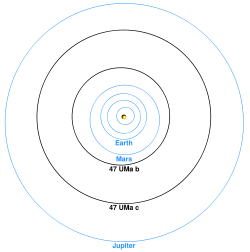47 Ursae Majoris
2007 Schools Wikipedia Selection. Related subjects: Space (Astronomy)
| Observation data Epoch J2000.0 |
|
|---|---|
| Constellation | Ursa Major |
| Right ascension | 10h 59m 28.0s |
| Declination | +40° 25′ 49″ |
| Apparent magnitude (V) | +5.03 |
| Characteristics | |
| Spectral type | G1V |
| B-V colour index | 0.61 |
| U-B colour index | 0.13 |
| Variable type | none |
| Astrometry | |
| Radial velocity (Rv) | +12.6 km/s |
| Proper motion (μ) | RA: -315.92 mas/ yr Dec.: 55.15 mas/ yr |
| Parallax (π) | 71.04 ± 0.66 mas |
| Distance | 45.9 ± 0.4 ly (14.1 ± 0.1 pc) |
| Absolute magnitude (MV) | 4.29 |
| Details | |
| Mass | 1.03 M☉ |
| Radius | 1.26 R☉ |
| Luminosity | 1.54 L☉ |
| Temperature | 5,740 K |
| Metallicity | 110% |
| Rotation | ~3 km/s. |
| Age | 6.03 × 109 years |
| Other designations | |
|
Gl 407, HR 4277, BD +41°2147, HD 95128, LTT 12934, GCTP 2556.00, SAO 43557, FK5 1282, GC 15087, HIP 53721.
|
|
47 Ursae Majoris (abbreviated 47 UMa) is a yellow dwarf star similar to our Sun located approximately 46 light-years away in the constellation Ursa Major. As of 2002, 47 Ursae Majoris is known to have two extrasolar planets orbiting it. 47 Ursae Majoris is ranked 72nd in the list of top 100 target stars for the NASA Terrestrial Planet Finder mission.
Distance and visibility
47 Ursae Majoris is located fairly close to our solar system: according to astrometric measurements made by the Hipparcos astrometry satellite, the star exhibits a parallax of 71.04 milliarcseconds, corresponding to a distance of 14.1 parsecs. With an apparent magnitude of +5.03, it is visible to the naked eye under good conditions.
Stellar characteristics
47 Ursae Majoris has a similar mass to that of our Sun. It is slightly more metal-rich than the Sun, having around 110% of the solar abundance of iron. With a spectral type of G1V, it is also slightly hotter than the Sun, at around 5,855 K. 47 Ursae Majoris has an absolute magnitude of +4.29, implying it has a visual luminosity around 60% greater than the Sun.
Like the Sun, 47 Ursae Majoris is on the main sequence, converting hydrogen to helium in its core by nuclear fusion. Based on its chromospheric activity, the star may be around 6,000 million years old, though evolutionary models suggest an older age of around 8,700 million years.
Planetary system
In 1996 an extrasolar planet was announced in orbit around 47 Ursae Majoris by Geoffrey Marcy and R. Paul Butler. The discovery was made by observing the change in the star's radial velocity as the planet's gravity pulled it around. The measurements were made by observing the Doppler shift of the star's spectrum. The planet, designated 47 Ursae Majoris b was the first long- period extrasolar planet discovered. Unlike the majority of known long-period extrasolar planets, 47 Ursae Majoris b has a low- eccentricity orbit. The planet is at least 2.63 times the mass of Jupiter and takes 1,089 days to orbit its star. If located in our solar system, it would lie between the orbits of Mars and Jupiter.
In 2001, preliminary astrometric measurements suggest the orbit of 47 Ursae Majoris b is inclined at an angle of 63.1° to the plane of the sky. If these measurements are confirmed, this implies the planet's true mass is around 2.9 times that of Jupiter.
A second planet, designated 47 Ursae Majoris c was announced in 2002 by Debra Fischer, Geoffrey Marcy and R. Paul Butler. The discovery was made using the same radial velocity method used to detect the first planet. 47 Ursae Majoris c is also in a long-period orbit, taking around 2,594 days to complete. The eccentricity of the orbit is not as well known as that of the inner planet, though it is likely to be low.
The two known planets are in a similar configuration to Jupiter and Saturn in our solar system: the ratio of orbital periods in both cases is close to 5:2, and the mass ratios are similar. The smaller scale and higher masses of the 47 Ursae Majoris system implies that the planets experience stronger mutual perturbations than Jupiter and Saturn do, which suggests the true masses of the planets are not much greater than the lower limits obtained by the radial velocity method.
Simulations suggest that the inner part of the habitable zone of 47 Ursae Majoris could host a terrestrial planet on a stable orbit, though the outer regions of the habitable zone would be disrupted by the gravitational influence of the planet 47 Ursae Majoris b. However, the presence of a giant planet within 2.5 AU of the star may have disrupted planet formation in the inner system, and reduced the amount of water delivered to inner planets during accretion. This may mean any terrestrial planets orbiting in the habitable zone of 47 Ursae Majoris are likely to be small and dry.
| Companion (In order from star) |
Mass ( MJ) |
Orbital period (days) |
Semimajor axis ( AU) |
Eccentricity |
|---|---|---|---|---|
| b | >2.63 ± 0.23 | 1089.0 ± 2.9 | 2.13 ± 0.12 | 0.061 ± 0.014 |
| c | >0.79 ± 0.13 | 2594 ± 90 | 3.79 ± 0.24 | 0.00 ± 0.12 |
47 Ursae Majoris in fiction
47 Ursae Majoris is the setting of the Coyote series by Allen Steele: much of the action takes place on Coyote, a fictional habitable moon of 47 Ursae Majoris b, which is named Bear in the books.
